Rishabh Gupta
ReXCL: A Tool for Requirement Document Extraction and Classification
Apr 10, 2025Abstract:This paper presents the ReXCL tool, which automates the extraction and classification processes in requirement engineering, enhancing the software development lifecycle. The tool features two main modules: Extraction, which processes raw requirement documents into a predefined schema using heuristics and predictive modeling, and Classification, which assigns class labels to requirements using adaptive fine-tuning of encoder-based models. The final output can be exported to external requirement engineering tools. Performance evaluations indicate that ReXCL significantly improves efficiency and accuracy in managing requirements, marking a novel approach to automating the schematization of semi-structured requirement documents.
MAIDS: Malicious Agent Identification-based Data Security Model for Cloud Environments
Dec 19, 2024Abstract:With the vigorous development of cloud computing, most organizations have shifted their data and applications to the cloud environment for storage, computation, and sharing purposes. During storage and data sharing across the participating entities, a malicious agent may gain access to outsourced data from the cloud environment. A malicious agent is an entity that deliberately breaches the data. This information accessed might be misused or revealed to unauthorized parties. Therefore, data protection and prediction of malicious agents have become a demanding task that needs to be addressed appropriately. To deal with this crucial and challenging issue, this paper presents a Malicious Agent Identification-based Data Security (MAIDS) Model which utilizes XGBoost machine learning classification algorithm for securing data allocation and communication among different participating entities in the cloud system. The proposed model explores and computes intended multiple security parameters associated with online data communication or transactions. Correspondingly, a security-focused knowledge database is produced for developing the XGBoost Classifier-based Malicious Agent Prediction (XC-MAP) unit. Unlike the existing approaches, which only identify malicious agents after data leaks, MAIDS proactively identifies malicious agents by examining their eligibility for respective data access. In this way, the model provides a comprehensive solution to safeguard crucial data from both intentional and non-intentional breaches, by granting data to authorized agents only by evaluating the agents behavior and predicting the malicious agent before granting data.
* 28 pages, 10 figures
Selective Shot Learning for Code Explanation
Dec 17, 2024
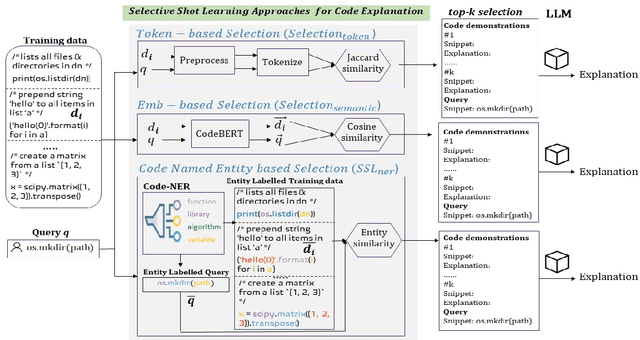
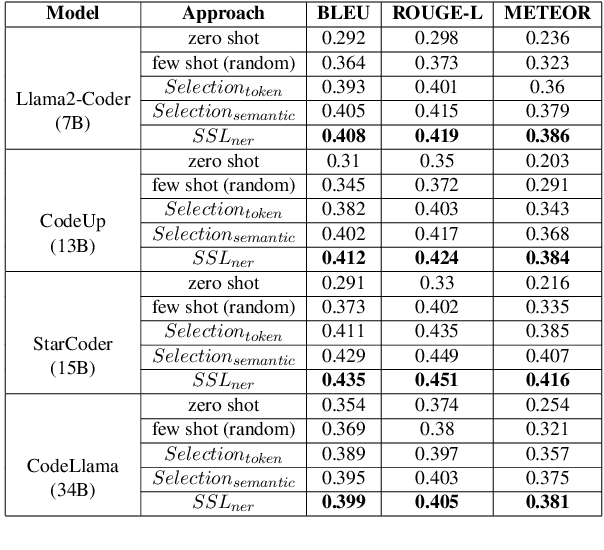
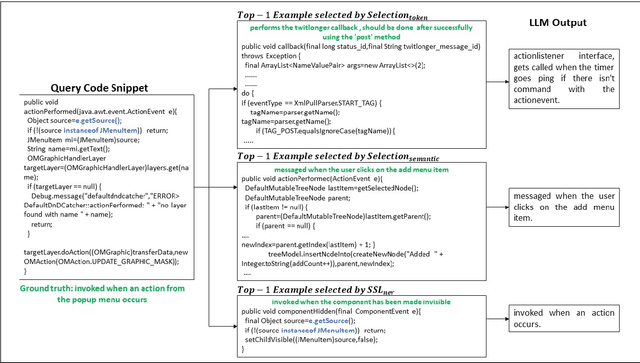
Abstract:Code explanation plays a crucial role in the software engineering domain, aiding developers in grasping code functionality efficiently. Recent work shows that the performance of LLMs for code explanation improves in a few-shot setting, especially when the few-shot examples are selected intelligently. State-of-the-art approaches for such Selective Shot Learning (SSL) include token-based and embedding-based methods. However, these SSL approaches have been evaluated on proprietary LLMs, without much exploration on open-source Code-LLMs. Additionally, these methods lack consideration for programming language syntax. To bridge these gaps, we present a comparative study and propose a novel SSL method (SSL_ner) that utilizes entity information for few-shot example selection. We present several insights and show the effectiveness of SSL_ner approach over state-of-the-art methods across two datasets. To the best of our knowledge, this is the first systematic benchmarking of open-source Code-LLMs while assessing the performances of the various few-shot examples selection approaches for the code explanation task.
Digital Twin Generators for Disease Modeling
May 02, 2024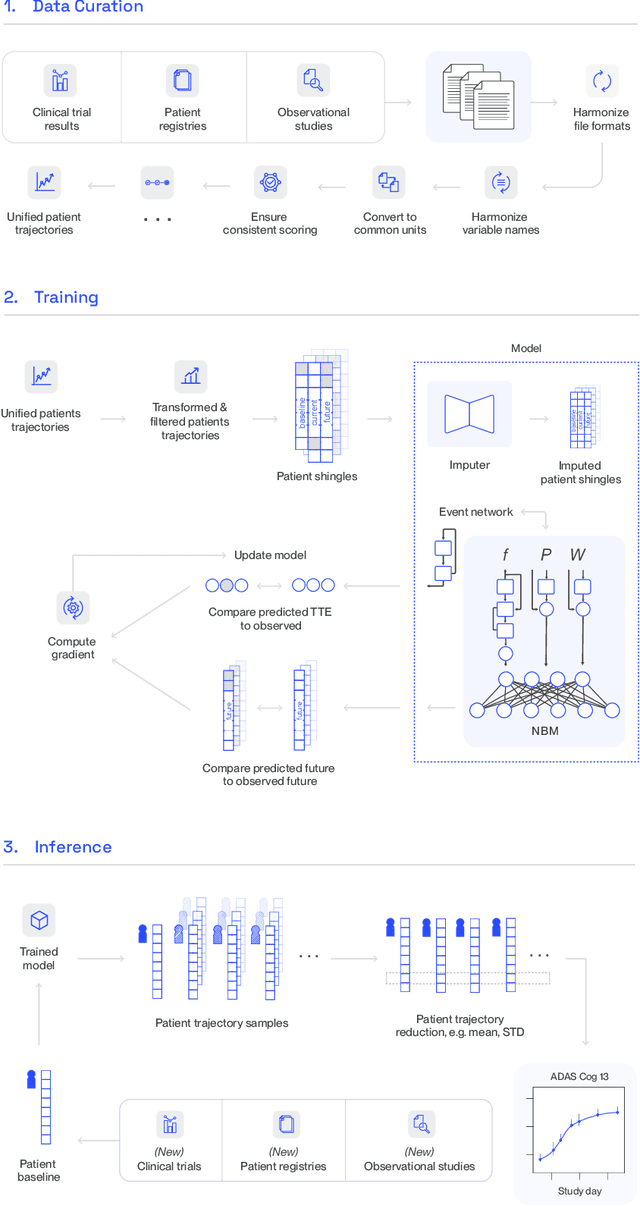
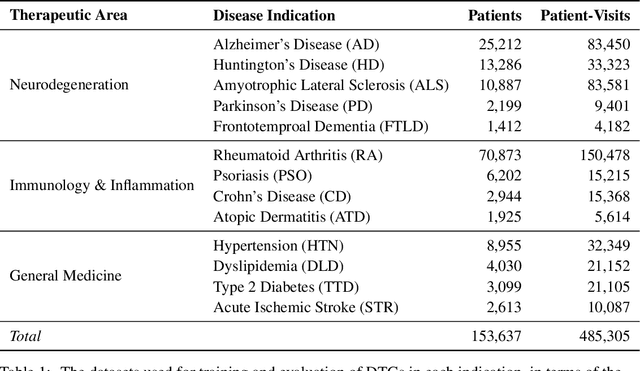
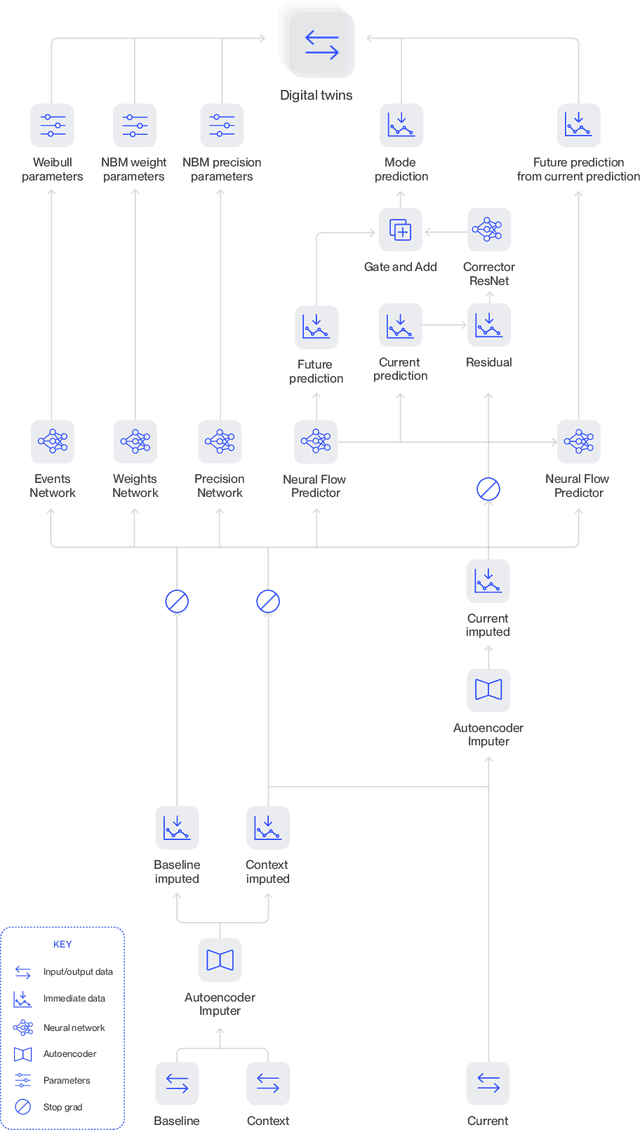
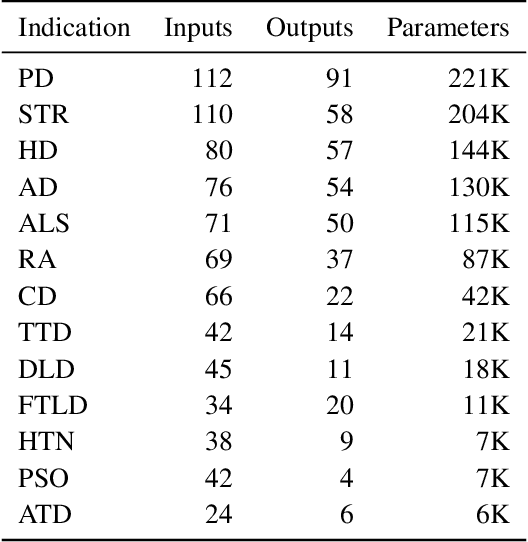
Abstract:A patient's digital twin is a computational model that describes the evolution of their health over time. Digital twins have the potential to revolutionize medicine by enabling individual-level computer simulations of human health, which can be used to conduct more efficient clinical trials or to recommend personalized treatment options. Due to the overwhelming complexity of human biology, machine learning approaches that leverage large datasets of historical patients' longitudinal health records to generate patients' digital twins are more tractable than potential mechanistic models. In this manuscript, we describe a neural network architecture that can learn conditional generative models of clinical trajectories, which we call Digital Twin Generators (DTGs), that can create digital twins of individual patients. We show that the same neural network architecture can be trained to generate accurate digital twins for patients across 13 different indications simply by changing the training set and tuning hyperparameters. By introducing a general purpose architecture, we aim to unlock the ability to scale machine learning approaches to larger datasets and across more indications so that a digital twin could be created for any patient in the world.
Deep Learning Based Named Entity Recognition Models for Recipes
Feb 27, 2024Abstract:Food touches our lives through various endeavors, including flavor, nourishment, health, and sustainability. Recipes are cultural capsules transmitted across generations via unstructured text. Automated protocols for recognizing named entities, the building blocks of recipe text, are of immense value for various applications ranging from information extraction to novel recipe generation. Named entity recognition is a technique for extracting information from unstructured or semi-structured data with known labels. Starting with manually-annotated data of 6,611 ingredient phrases, we created an augmented dataset of 26,445 phrases cumulatively. Simultaneously, we systematically cleaned and analyzed ingredient phrases from RecipeDB, the gold-standard recipe data repository, and annotated them using the Stanford NER. Based on the analysis, we sampled a subset of 88,526 phrases using a clustering-based approach while preserving the diversity to create the machine-annotated dataset. A thorough investigation of NER approaches on these three datasets involving statistical, fine-tuning of deep learning-based language models and few-shot prompting on large language models (LLMs) provides deep insights. We conclude that few-shot prompting on LLMs has abysmal performance, whereas the fine-tuned spaCy-transformer emerges as the best model with macro-F1 scores of 95.9%, 96.04%, and 95.71% for the manually-annotated, augmented, and machine-annotated datasets, respectively.
Sparse Graph Representations for Procedural Instructional Documents
Feb 06, 2024Abstract:Computation of document similarity is a critical task in various NLP domains that has applications in deduplication, matching, and recommendation. Traditional approaches for document similarity computation include learning representations of documents and employing a similarity or a distance function over the embeddings. However, pairwise similarities and differences are not efficiently captured by individual representations. Graph representations such as Joint Concept Interaction Graph (JCIG) represent a pair of documents as a joint undirected weighted graph. JCIGs facilitate an interpretable representation of document pairs as a graph. However, JCIGs are undirected, and don't consider the sequential flow of sentences in documents. We propose two approaches to model document similarity by representing document pairs as a directed and sparse JCIG that incorporates sequential information. We propose two algorithms inspired by Supergenome Sorting and Hamiltonian Path that replace the undirected edges with directed edges. Our approach also sparsifies the graph to $O(n)$ edges from JCIG's worst case of $O(n^2)$. We show that our sparse directed graph model architecture consisting of a Siamese encoder and GCN achieves comparable results to the baseline on datasets not containing sequential information and beats the baseline by ten points on an instructional documents dataset containing sequential information.
Exploring Large Language Models for Code Explanation
Oct 25, 2023


Abstract:Automating code documentation through explanatory text can prove highly beneficial in code understanding. Large Language Models (LLMs) have made remarkable strides in Natural Language Processing, especially within software engineering tasks such as code generation and code summarization. This study specifically delves into the task of generating natural-language summaries for code snippets, using various LLMs. The findings indicate that Code LLMs outperform their generic counterparts, and zero-shot methods yield superior results when dealing with datasets with dissimilar distributions between training and testing sets.
Data-driven decision-focused surrogate modeling
Aug 23, 2023Abstract:We introduce the concept of decision-focused surrogate modeling for solving computationally challenging nonlinear optimization problems in real-time settings. The proposed data-driven framework seeks to learn a simpler, e.g. convex, surrogate optimization model that is trained to minimize the decision prediction error, which is defined as the difference between the optimal solutions of the original and the surrogate optimization models. The learning problem, formulated as a bilevel program, can be viewed as a data-driven inverse optimization problem to which we apply a decomposition-based solution algorithm from previous work. We validate our framework through numerical experiments involving the optimization of common nonlinear chemical processes such as chemical reactors, heat exchanger networks, and material blending systems. We also present a detailed comparison of decision-focused surrogate modeling with standard data-driven surrogate modeling methods and demonstrate that our approach is significantly more data-efficient while producing simple surrogate models with high decision prediction accuracy.
Counterspeeches up my sleeve! Intent Distribution Learning and Persistent Fusion for Intent-Conditioned Counterspeech Generation
May 23, 2023



Abstract:Counterspeech has been demonstrated to be an efficacious approach for combating hate speech. While various conventional and controlled approaches have been studied in recent years to generate counterspeech, a counterspeech with a certain intent may not be sufficient in every scenario. Due to the complex and multifaceted nature of hate speech, utilizing multiple forms of counter-narratives with varying intents may be advantageous in different circumstances. In this paper, we explore intent-conditioned counterspeech generation. At first, we develop IntentCONAN, a diversified intent-specific counterspeech dataset with 6831 counterspeeches conditioned on five intents, i.e., informative, denouncing, question, positive, and humour. Subsequently, we propose QUARC, a two-stage framework for intent-conditioned counterspeech generation. QUARC leverages vector-quantized representations learned for each intent category along with PerFuMe, a novel fusion module to incorporate intent-specific information into the model. Our evaluation demonstrates that QUARC outperforms several baselines by an average of 10% across evaluation metrics. An extensive human evaluation supplements our hypothesis of better and more appropriate responses than comparative systems.
Speaker Profiling in Multiparty Conversations
Apr 19, 2023Abstract:In conversational settings, individuals exhibit unique behaviors, rendering a one-size-fits-all approach insufficient for generating responses by dialogue agents. Although past studies have aimed to create personalized dialogue agents using speaker persona information, they have relied on the assumption that the speaker's persona is already provided. However, this assumption is not always valid, especially when it comes to chatbots utilized in industries like banking, hotel reservations, and airline bookings. This research paper aims to fill this gap by exploring the task of Speaker Profiling in Conversations (SPC). The primary objective of SPC is to produce a summary of persona characteristics for each individual speaker present in a dialogue. To accomplish this, we have divided the task into three subtasks: persona discovery, persona-type identification, and persona-value extraction. Given a dialogue, the first subtask aims to identify all utterances that contain persona information. Subsequently, the second task evaluates these utterances to identify the type of persona information they contain, while the third subtask identifies the specific persona values for each identified type. To address the task of SPC, we have curated a new dataset named SPICE, which comes with specific labels. We have evaluated various baselines on this dataset and benchmarked it with a new neural model, SPOT, which we introduce in this paper. Furthermore, we present a comprehensive analysis of SPOT, examining the limitations of individual modules both quantitatively and qualitatively.
 Add to Chrome
Add to Chrome Add to Firefox
Add to Firefox Add to Edge
Add to Edge